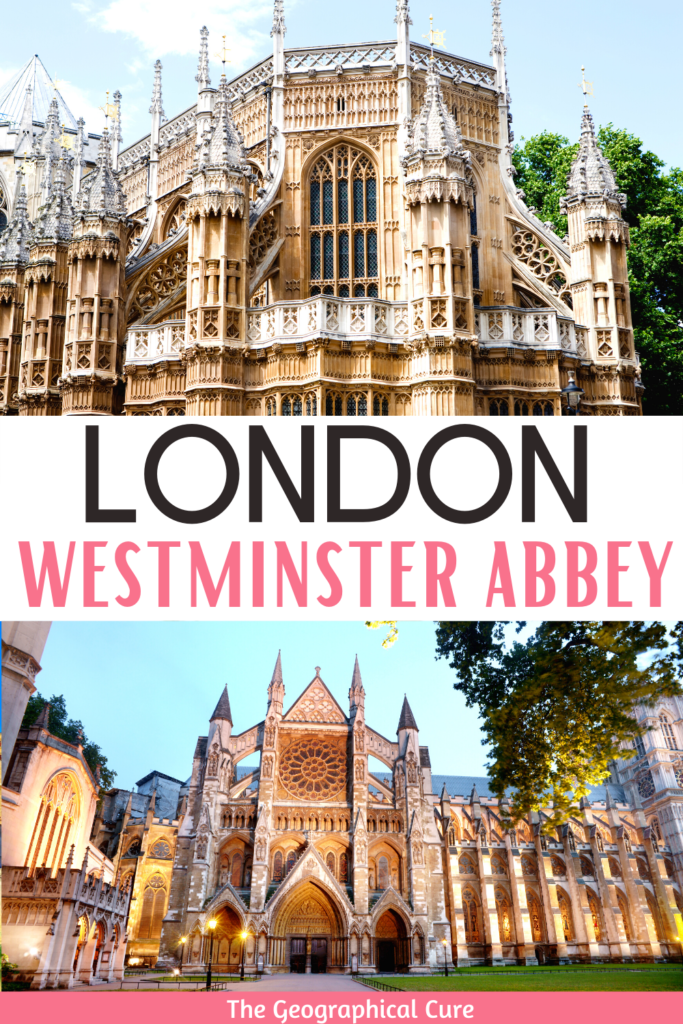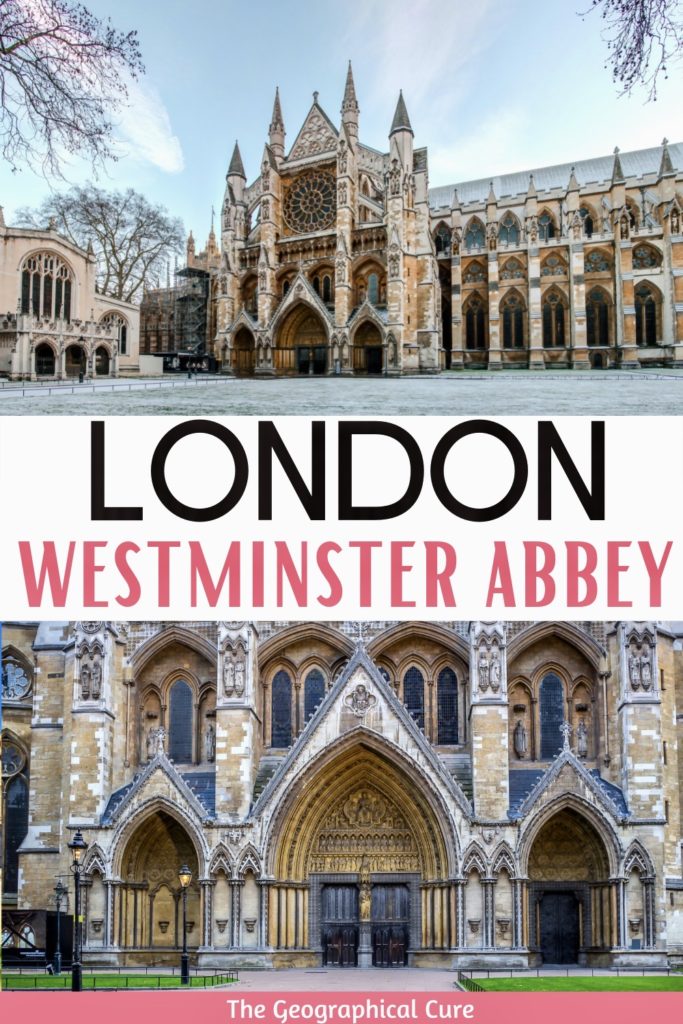Westminster Abbey is a iconic landmark that’s an absolute must visit attraction in London. It’s the most historic church in the English-speaking world.
Founded by Edward the Confessor, the abbey is a shrine of the British nation and a UNESCO-listed site. The complex has been an abbey, a cathedral, a coronation church, and a royal mausoleum.
This spectacular medieval “royal peculiar” has hosted every coronation from William the Conqueror to Elizabeth II and 16 royal weddings. It’s also the burial place of many royals and notables, including feuding Tudor siblings Elizabeth I and Mary.
This Westminster Abbey guide gives you an overview of the abbey’s 1,000 year history and tells you everything to see inside. I also give you must know tips for visiting.
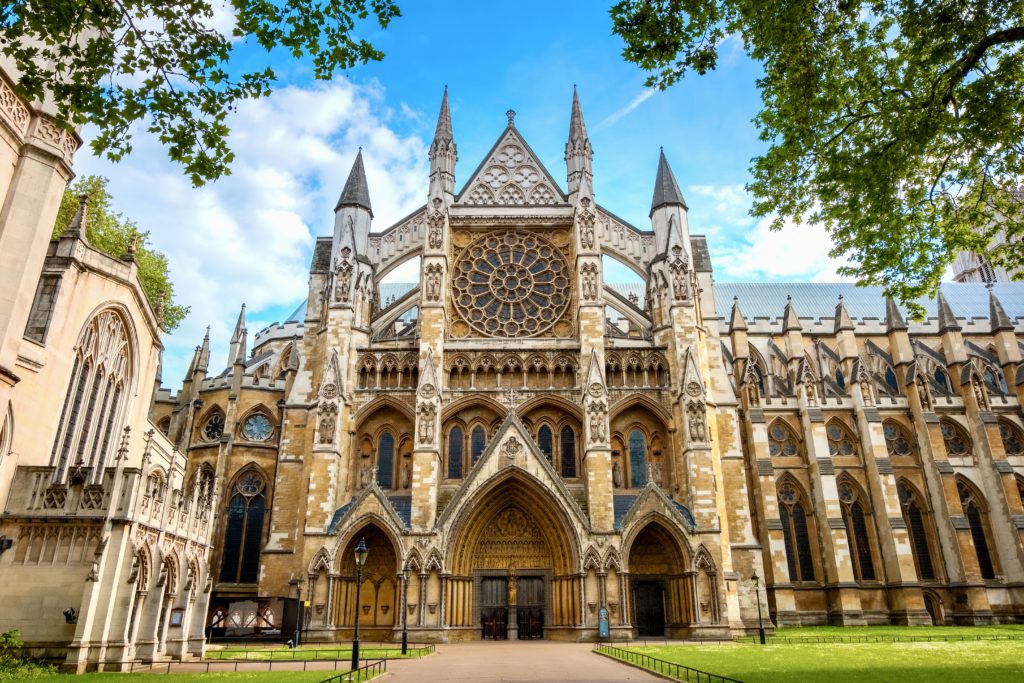
Here’s a snapshot of what you can see at Westminster Abbey on a visit:
- nave
- statesmen aisle
- high altar
- shrine of Edward the Confessor
- royal tombs
- Henry VIII’s Lady Chapel
- poets corner
- diamond jubilee galleries
- cloisters
- chapter house
- pyx chamber
- coronation throne
Tickets & Tours For Westminster Abbey
You definitely need to reserve a skip the line ticket in advance to visit the abbey. The lines will be long in high season.
Click here to pre-book a ticket to Westminster Abbey. The abbey is also free with the London Pass. But the pass doesn’t give you skip the line access to the abbey.
You may want to book a guided tour of the abbey. Click here for a 2 hour private guided tour of the abbey.
This tour gives you a combined tour of the abbey and the Houses of Parliament. This tour offers a 4 hour Westminster walking tour and abbey tour.
If you gotta see it all, this 8 hour guided tour takes you to Westminster Abbey and other iconic attractions in London.
History of Westminster Abbey
Westminster Abbey has been a place of worship for over 1,000 years. The abbey isn’t a cathedral. It’s techinically a “royal peculiar” – a place of worship that falls under the monarch’s jurisdiction and doesn’t belong to a diocese.
The abbey has the status of a collegiate church. Its official name is the Collegiate Church of Westminster.
In 906, St. Dunstan, the Bishop of England, brought monks from Glastonbury to found a monastery at Westminster. Over 100 years later, in 1042, King Edward the Confessor founded a church on the site.
It was consecrated in 1065. Edward died a few days later.
After his death, Edward’s reputation as a holy and pious man grew. People came to the shrine in pilgrimage, praying for healing.
In 1161, Edward was officially made a saint. Henry III decided to build him a shrine in a more glorious Gothic church.
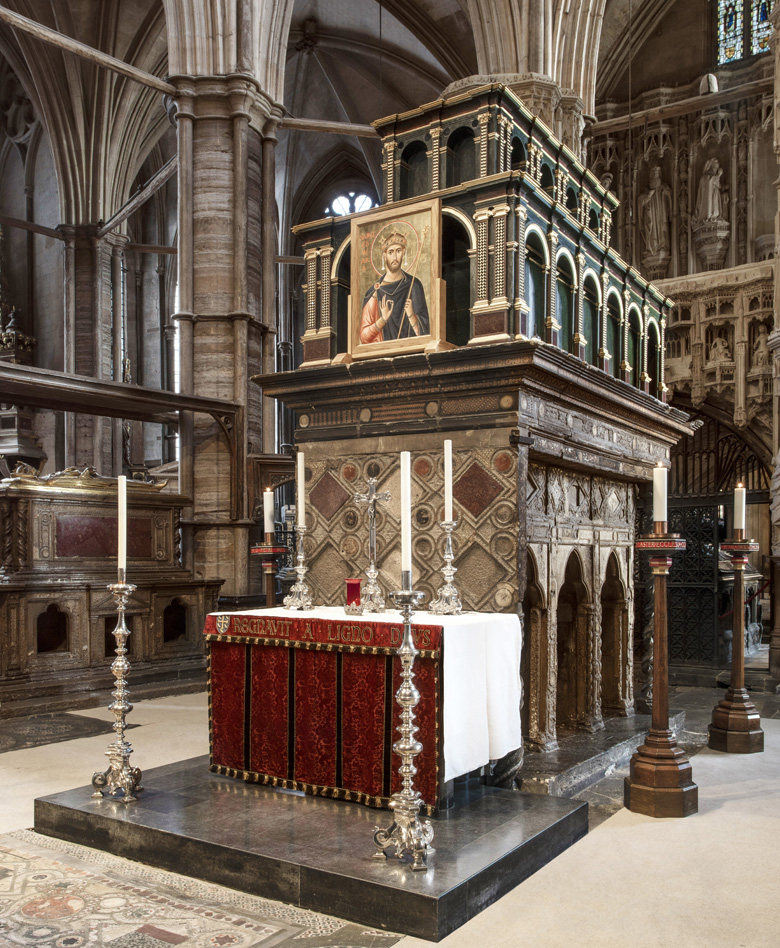
Construction of Westminster Abbey began in 1245 and continued for a couple centuries. In 1503, Henry VII began to build a new lady chapel, which stands at the far eastern end of the abbey.
In the 16th century, the infamous Henry VIII had fallen out with the pope, who refused to give him an annulment so he could marry Anne Boleyn.
In 1540, Henry VIII broke from the church and launched his own Anglican religion. He dissolved the monasteries and seized their assets to continue funding his castle building ways.
But Henry VIII did, at least, grant the Westminster Abbey cathedral status, thereby sparing it from the looting and destruction other monasteries suffered.
In 1533, Queen Mary took over the crown from her father Henry VIII. As a devout Catholic, she changed the abbey’s status back to a monastery.
Five years later, her sister Queen Elizabeth I came to the throne and reversed Mary’s orders. The abbey became a collegiate church.
Architecturally, the next major milestone didn’t come in 1745. This is when the two west towers were built according to the design of a Christopher Wren pupil. In the Victorian era, the triple portico was built and the rose window redesigned.
In 1995, the exterior stonework was cleaned and restored. In 1998, new statues were added to the Great West Door, including ten 20th century martyrs. You can even see Martin Luther King Jr.
In 2018, the Queen’s Jubilee Galleries were opened in the Triforum. The galleries display the abbey treasures and offer great views down over the nave.
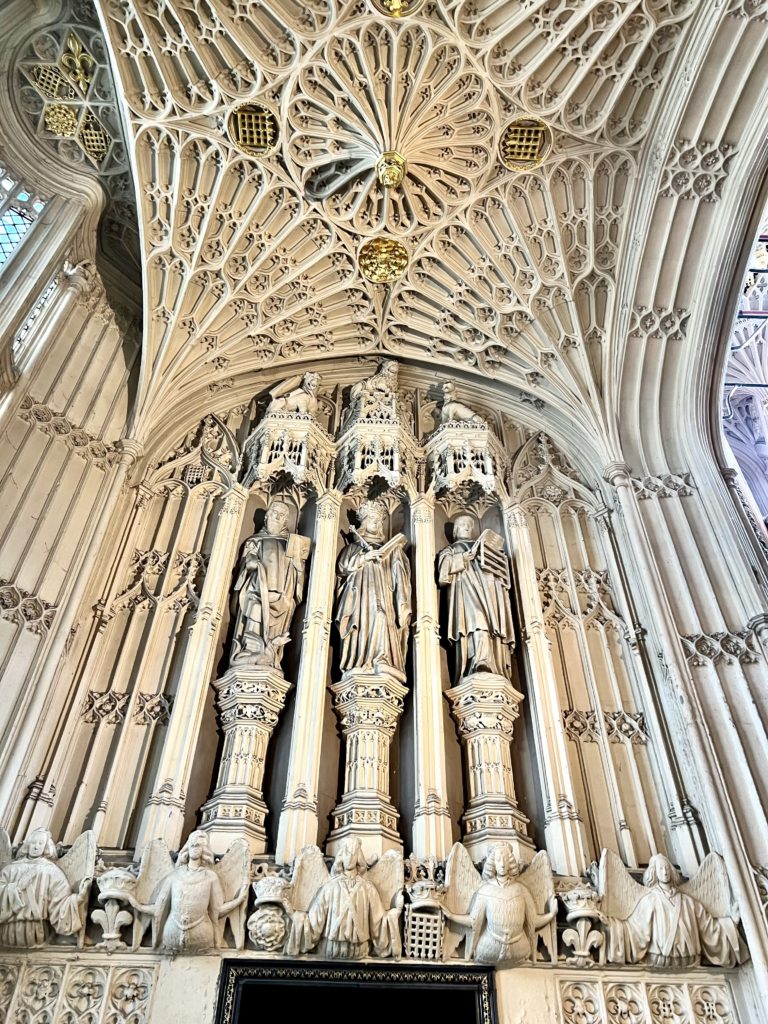
The Coronation Church
39 monarchs have been crowned in Westminster Abbey, beginning with England’s first king William the Conqueror.
In fact, Henry III specifically built the abbey as a coronation church. The long transepts allow plenty of seating for the glitterati.
The coronation ceremony follows a procedure that’s largely unchanged over time. The monarch is presented to the people by the Archbishop of Canterbury. Shouts of “God save the King or Queen” ring out from the grandstands.
The monarch signs an oath to govern properly. While sitting in the Coronation Chair, he or she is anointed with holy oil, given the symbols of monarchy, and crowned. Finally, the monarch is moved to the throne where he or she receives the homage of the subjects.
Elizabeth II’s coronation was the first one shown on live TV.
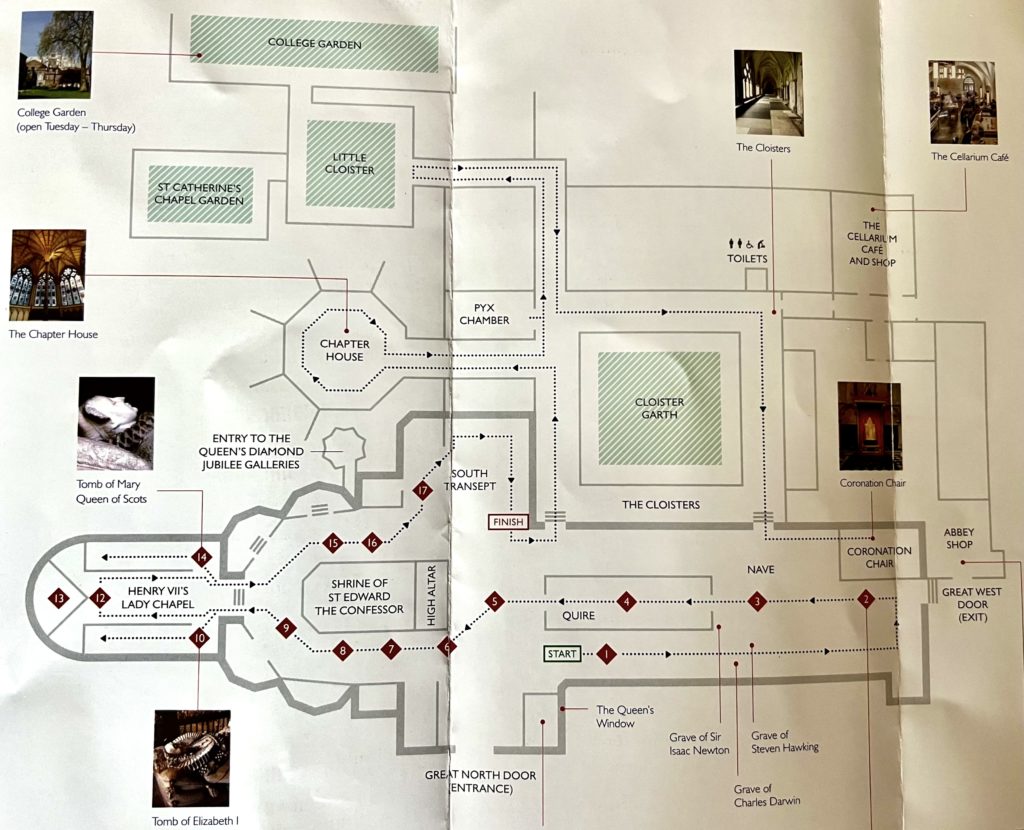
Guide To Westminster Abbey: What To See
Here are the must see highlights of the interior of the Abbey.
I’ve described them roughly in the order you’ll encounter them if you follow the trail on the map above.
1. Entrance
You enter the abbey via the door at the north transept. Your first impression is of a soaring vaulted space.
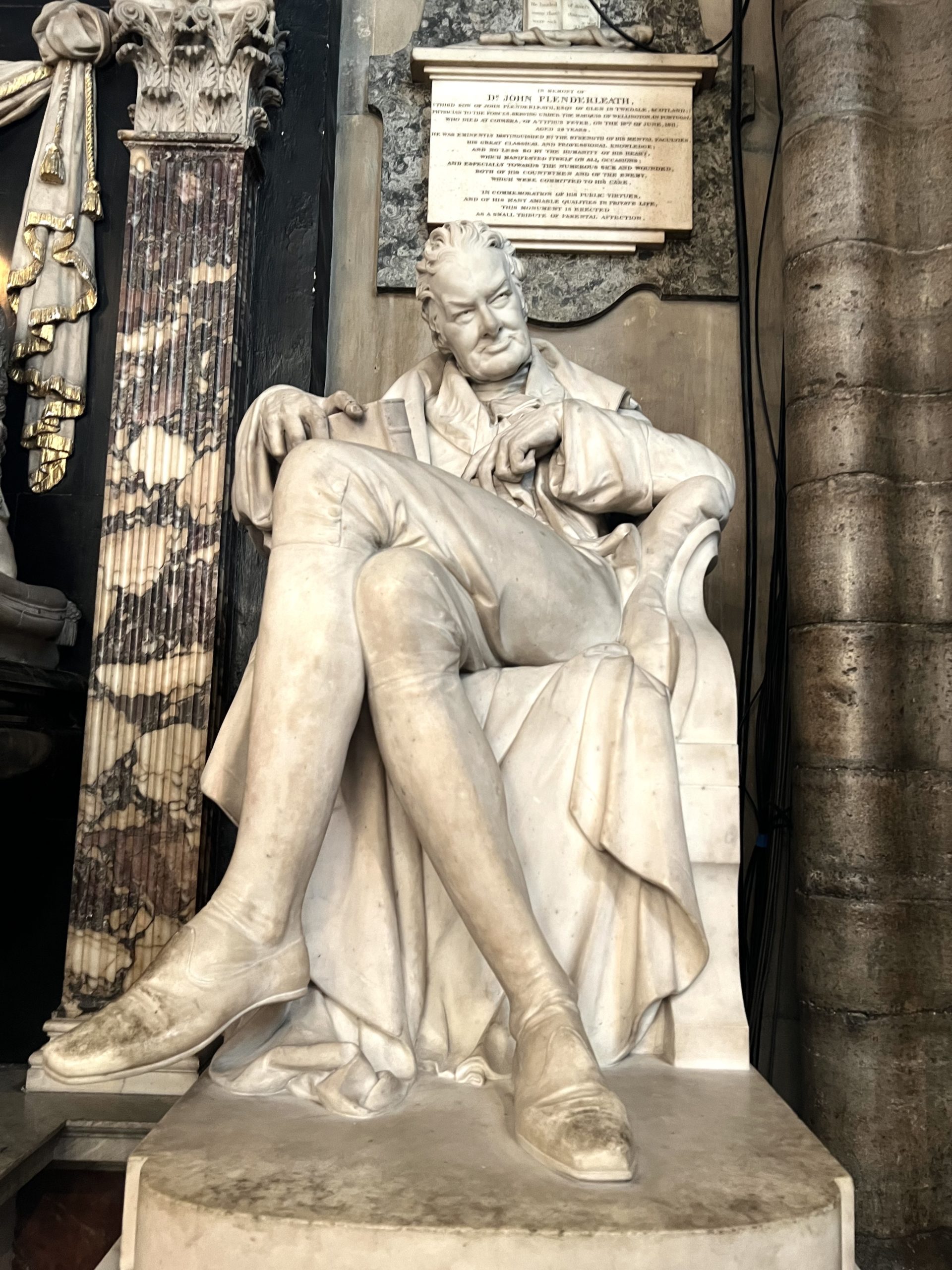
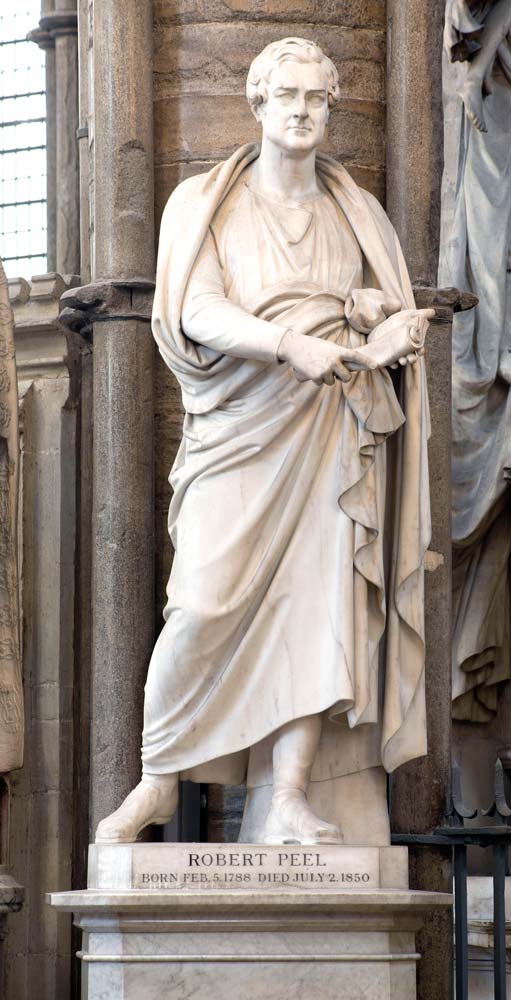
The history starts the second you walk in the door. You’ll see important figures from British history in the “Statesmen Aisle.”
There are larger than life statues honoring the leading Prime Ministers from the 18th and 19th centuries, including Viscount Patterson, Robert Peel, and Benjamin Disraeli. The tableaux suggests a strong link between the abbey and the British government.
The largest memorial in this area is dedicated to Prime Minister William Pitt. He is buried nearby with his son William Pitt the Younger. There is a plaque honoring the younger near the west door.
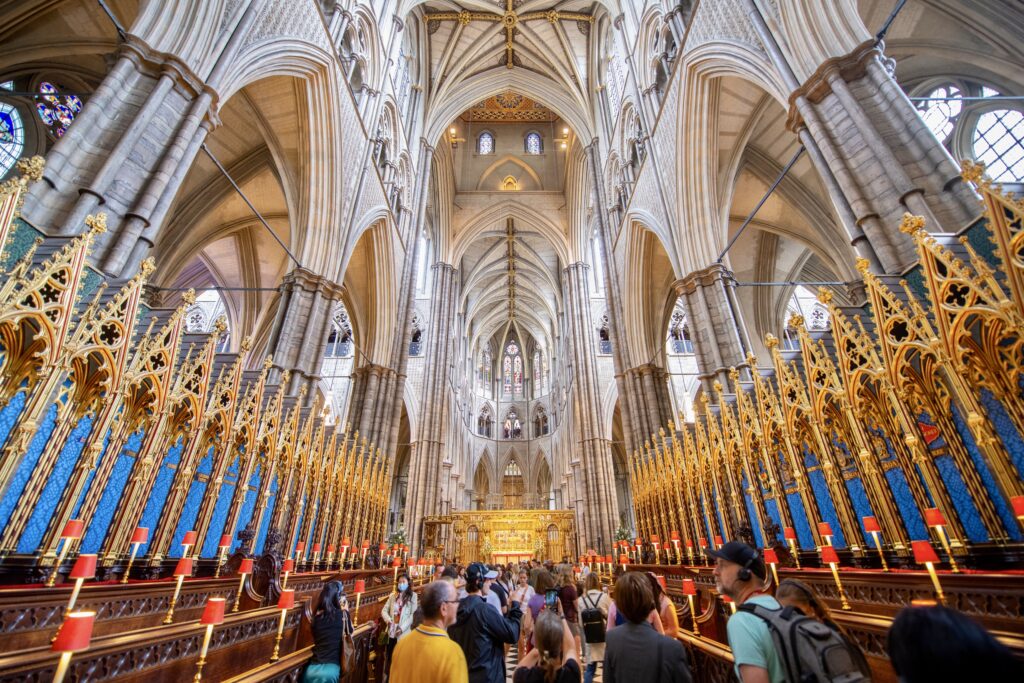
2. Nave
The nave is the central part of the church intended to hold the congregation. The abbey’s is a classic English nave.
Like other parts of the cathedral, it also honors important men and women. Set against the west facade facing the nave is the magnificent monument to Sir Issac Newton. He was a great British philosopher, scientist, and mathematician.
The sculpture reflects Newton’s interests. It features optical and mathematical instruments, books, and a globe showing the signs of the zodiac and constellations. Newton is buried just in front of the monument.
The naturalist and biologist Charles Darwin is buried nearby. In the center of the nave in the west end is a green marble stone commemorating Sir Winston Churchill.
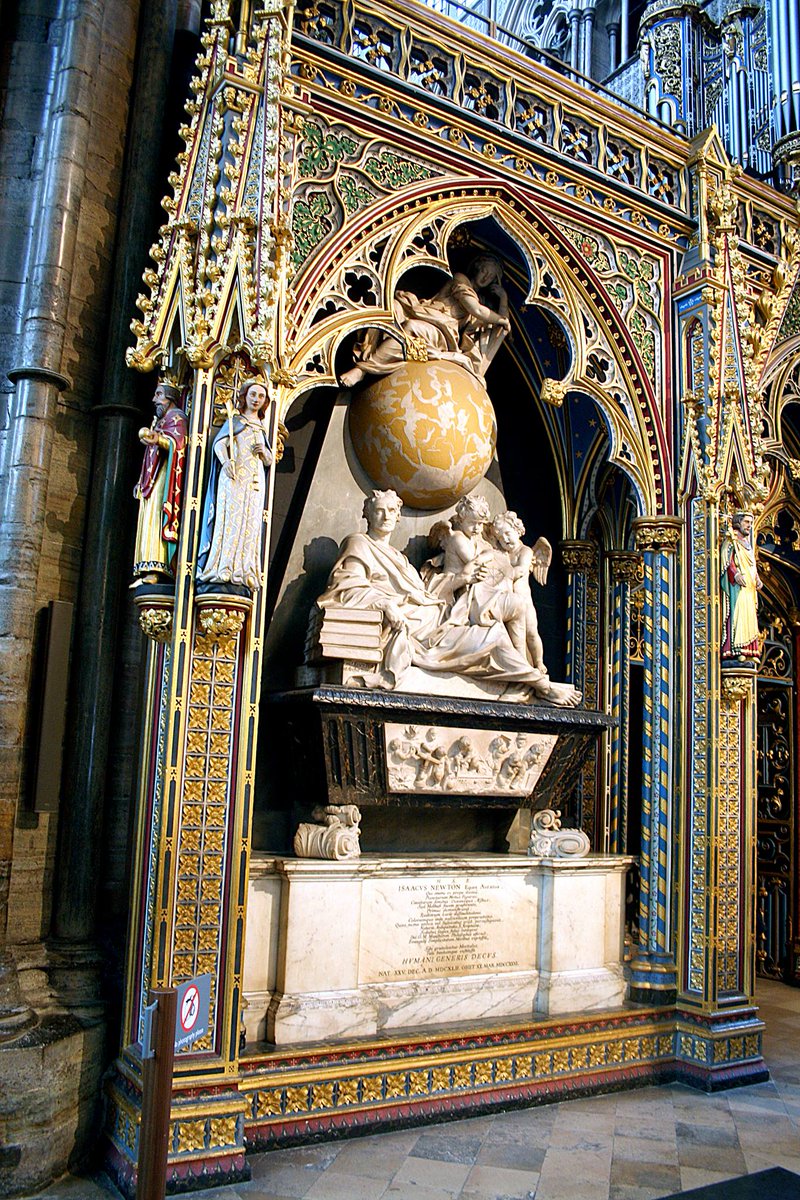
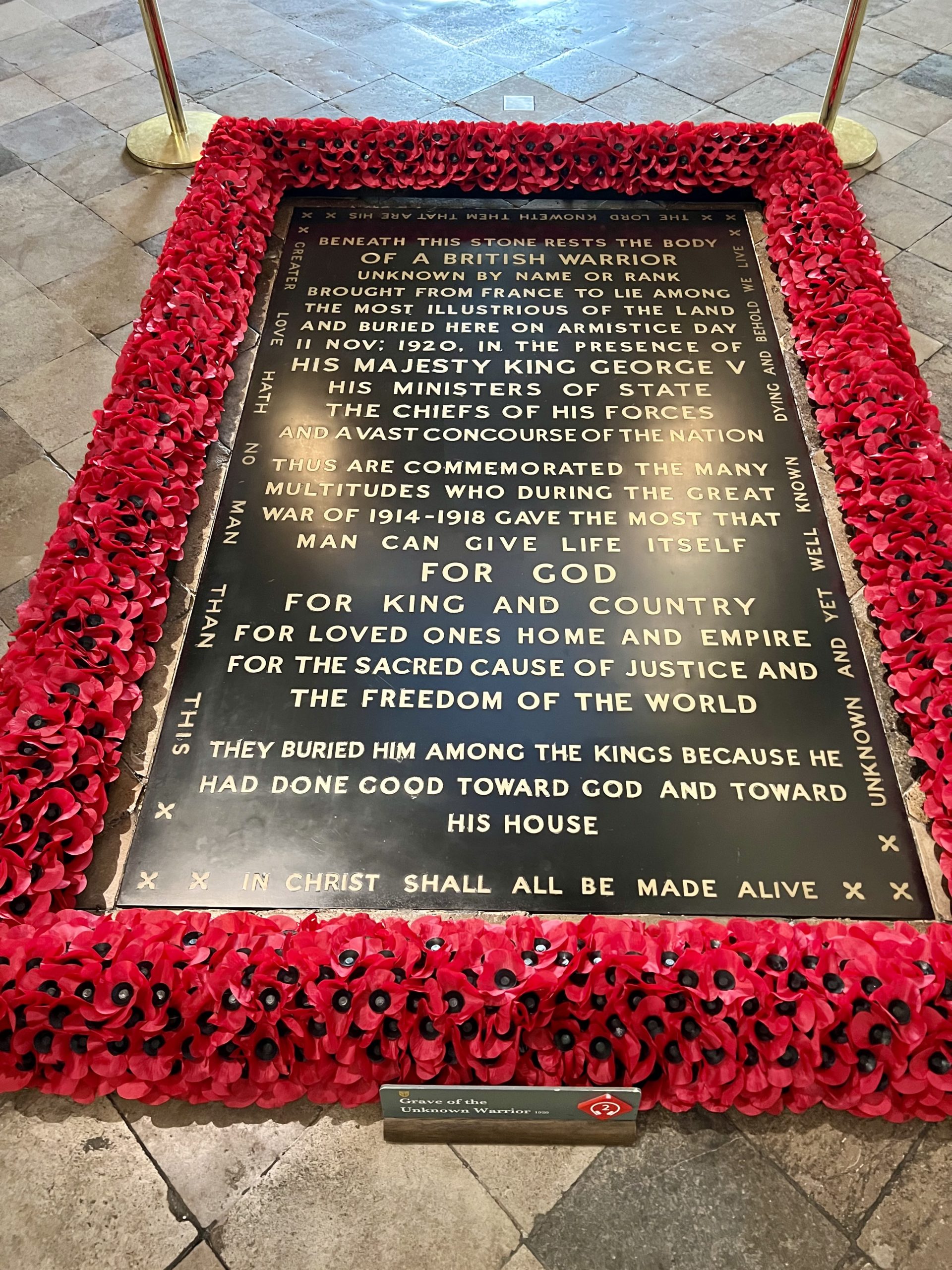
The most famous grave in the abbey that of the Unknown Soldier. It’s surrounded by a border of red poppies. I love that an unknown British soldier should be buried among the kings and queens.
3. Quire
The abbey’s world renowned quire is an intimate space. It’s effectively a church within a church.
The quire is divided from the nave by a elaborate screen designed by Edward Blore in 1834. It was gilded in the 1960s.
The quire was where the monks worshipped. Although not in these stalls, which date from the Victorian era. Today, the choir is occupied by eight regular choral services each work.
4. High Altar
The present High Altar dates from 1867. It was designed by George Gilbert Scott.
In front of the altar is one of the abbey’s most precious possessions, the medieval Cosmati Pavement. It was laid down in 1268 on the order of Henry III.
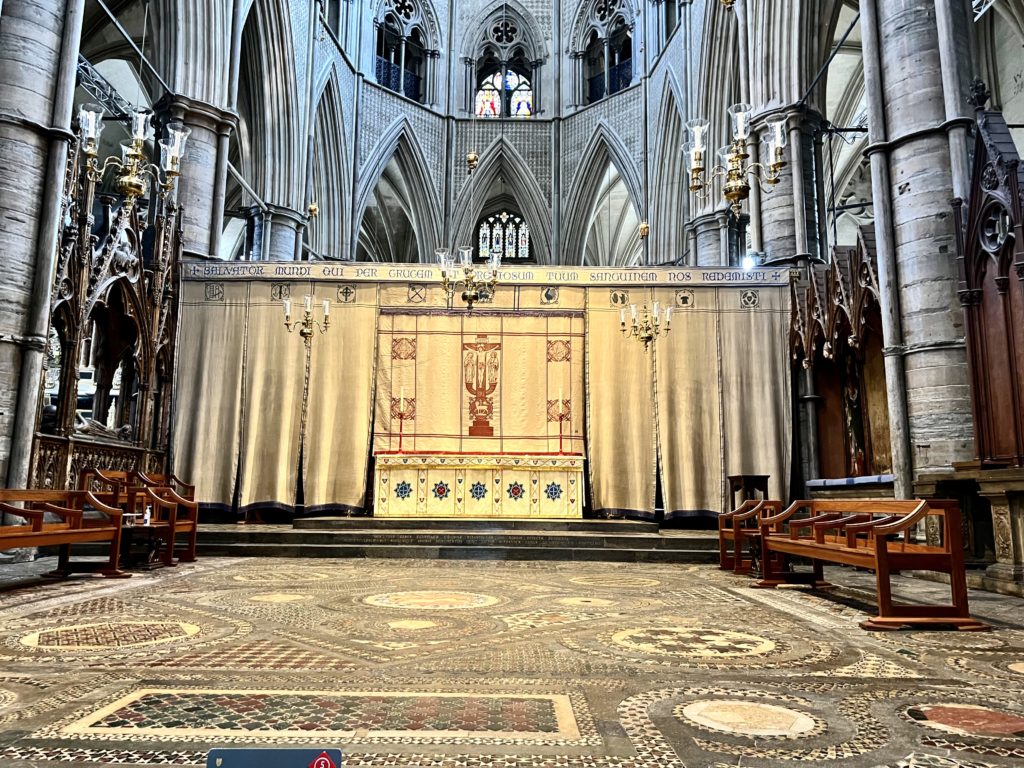
The tiles are made up of more than 80,000 pieces of onyx, porphyry, and glass set into Purbeck marble. The pavement was cleaned and restored before the wedding of William and Kate.
5. Shrine of Edward The Confessor
The Chapel of St. Edward is the spiritual heart of the abbey. It was here that the first pope visited the abbey.
Edward the Confessor’s remains were moved, or “translated,” many times before landing here. It was said that they were responsible for miracles.
The shrine was the work of Henry III, Edward’s biggest fan. He encrusted it with gold and jewels so that it shone like a beacon in then candlelit church.
Today, the shrine is hidden from view behind grills. You can only get a good look at it on a verger tour. (More on those below in the tips section.)
As he wanted, Henry III’s tomb is right nearby in a Purbeck marble tomb. It’s beautifully decorated with mosaics. Henry’s effigy is supposed to be a real likeness.
6. Henry VII’s Lady Chapel
The most beautiful part of Westminster Abbey is the stunning Henry VII Chapel in the eastern end.
The ancient chapel is the last great masterpiece of English medieval architecture, the crowning glory of the abbey, and the mausoleum for much of England’s royalty.
After its debut, the chapel was grandiosely nicknamed a “wonder of the world.”
The chapel is the work of England’s first Tudor monarch, Henry VII. He was the king who vanquished the York king, Richard III, in the Battle of Bosworth and seized control of England.
The chapel was dedicated to the Blessed Virgin Mary in 1503. It’s known as the Henry VII Chapel, although technically its name is the Lady Chapel.
The chapel’s architect is unknown. But historians believe that Robert Janyns, Jr. is the design genius.
Built between 1503-16, Henry VII broke the bank for his new chapel. It’s essentially an ornate homage to and keepsake of the Tudor dynasty. The whole chapel has the festive air of a medieval pageant.
Although built during the Renaissance period, Gothic architecture was still in vogue at the time. So, the chapel was built in the Perpendicular Gothic style.
This style is more ornate than French Gothic and uses highly decorative tracery effects. The chapel contrasts with the plainer Gothic style of the rest of the abbey.
The chapel’s most striking feature is its ornate high vaulted vaulted ceiling. The column piers splay out into a fan shape.
There’s elaborate highly decorative tracery everywhere. It obscures the structural system and hanging carved pendants.
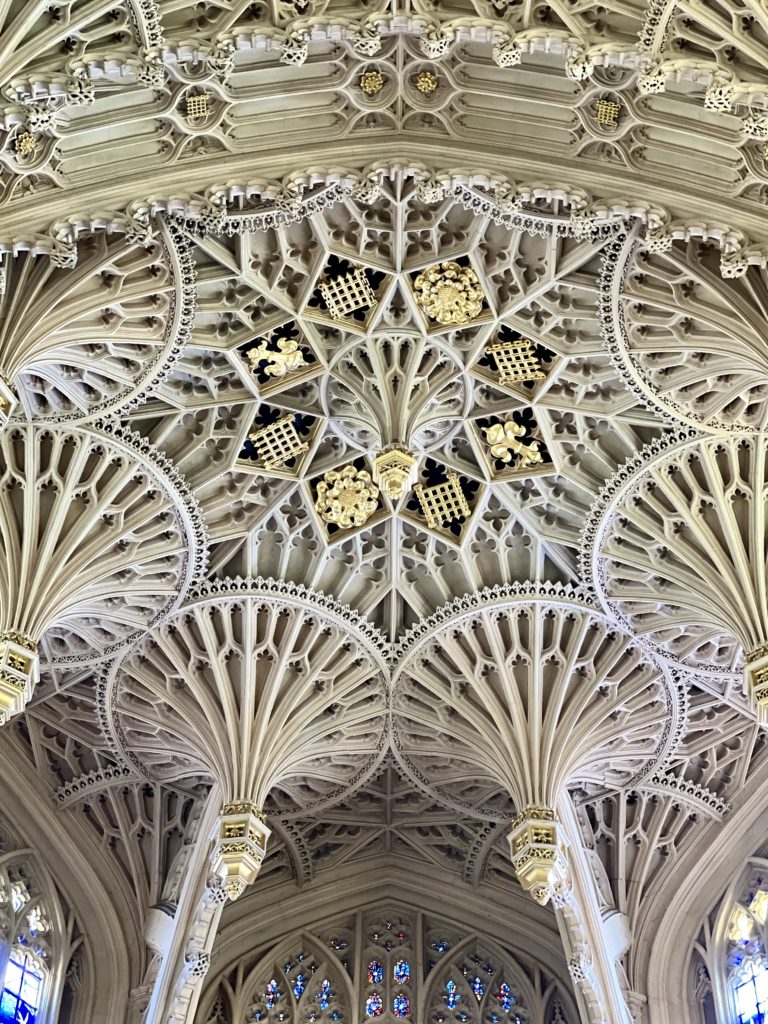
The pendants seem to defy gravity. They hang down like stalactites hanging from the roof of a fairy cavern.
The choir stalls were designated for all living Knights of the Most Honourable Order of the Bath. It was established in 1725 and is one of the premiere meritorious orders of the crown.
When a knight became part of the order, he received a stall that was adorned with his crest and coat of arms. You can see Lord Nelson’s stall plate on the south side.
Every four years, new knights are installed in a colorful ceremony. It’s attended by the Great Master, currently the Prince of Wales.
Throughout the chapel, you’ll see the motif of the “Tudor rose.” The rose is a mixture of the white rose of York and the red rose of Lancaster.
The motif was used heavily by Henry VII to emphasize the importance of the Tudor dynasty. It reiterated the legitimacy of his claim to the English throne, which was hotly debated during the War of the Roses.
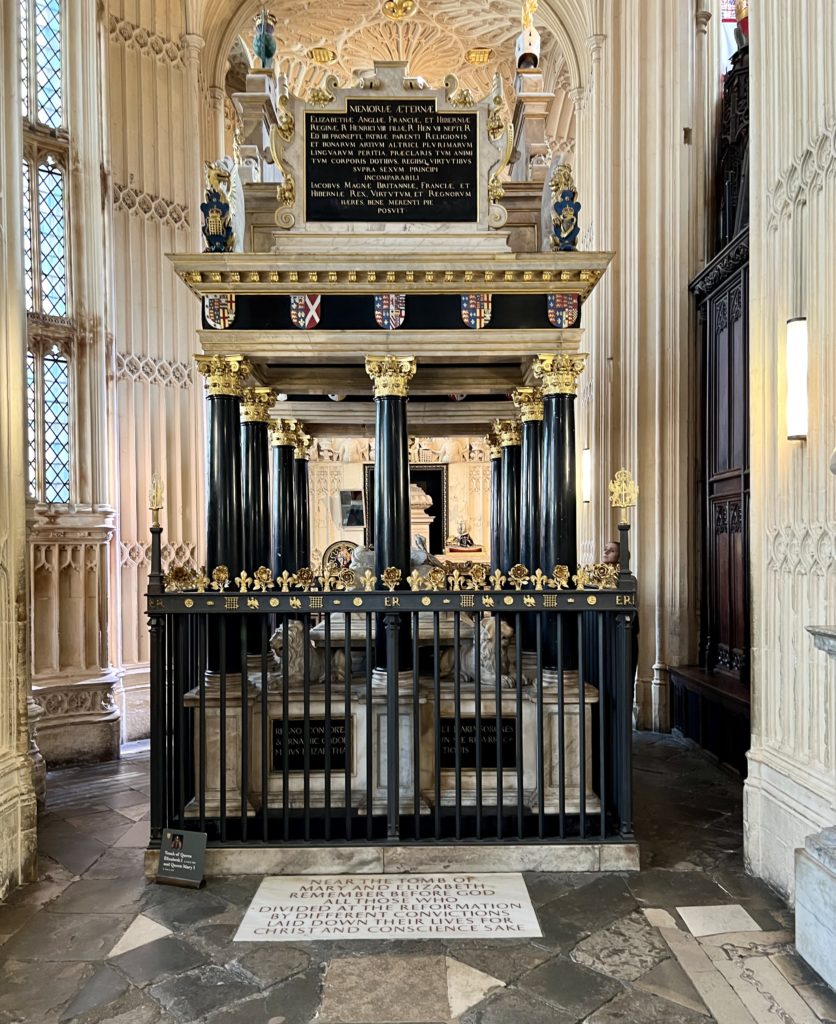
7. Royal Tombs: Who Is Buried In Westminster Abbey?
Many monarchs are memorialized with impressive tombs and monumental effigies in Westminster Abbey. Some of them were among the most important works of art from their age.
Times change though. Many recent royal burials are marked only by floor stones.
The royal tombs are mostly in the Henry VII Chapel, though not all. 15 kings and queens are buried in the Henry VII Chapel.
Henry VII and his wife, Elizabeth of York, share a magnificent Renaissance tomb. Their bronze gilt effigies were sculpted by Florentine artist Pietro Torrigiano, who had studied with Michelangelo. It lies behind the altar.
You’ll also find Henry VII’s granddaughter, Queen Elizabeth I. She was the daughter of the infamous Henry VIII and his second wife Anne Boleyn. Elizabeth’s royal orb symbolizes she was queen of the entire globe.
She’s buried in the chapel along with her half-sister, Mary I. At odds in life, they ironically lay together in death.
Henry VII’s mother, Margaret Beaufort, is also buried in the chapel. She was a rather evil (though ostensibly pious) lady who helped Henry VII secure the throne.
Beaufort likely would have been a CEO in today’s world. She died in 1509, shortly after Henry VIII’s coronation.
King James I is also buried in the vault beneath the monument. His tomb was only discovered in 1867 when Dean Stanley searched and excavated the royal tombs looking for James’ final resting place, which had gone unrecorded.
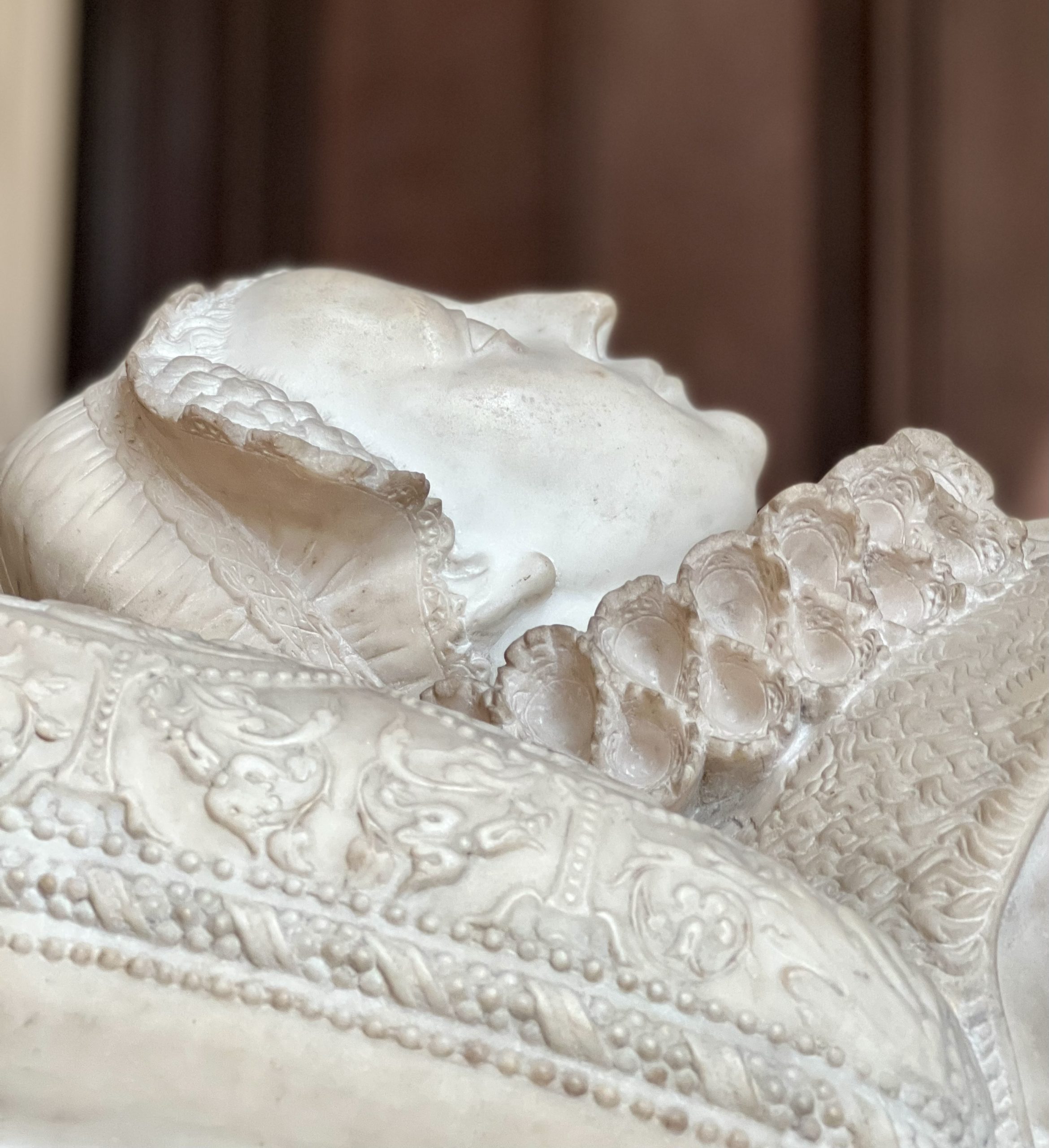
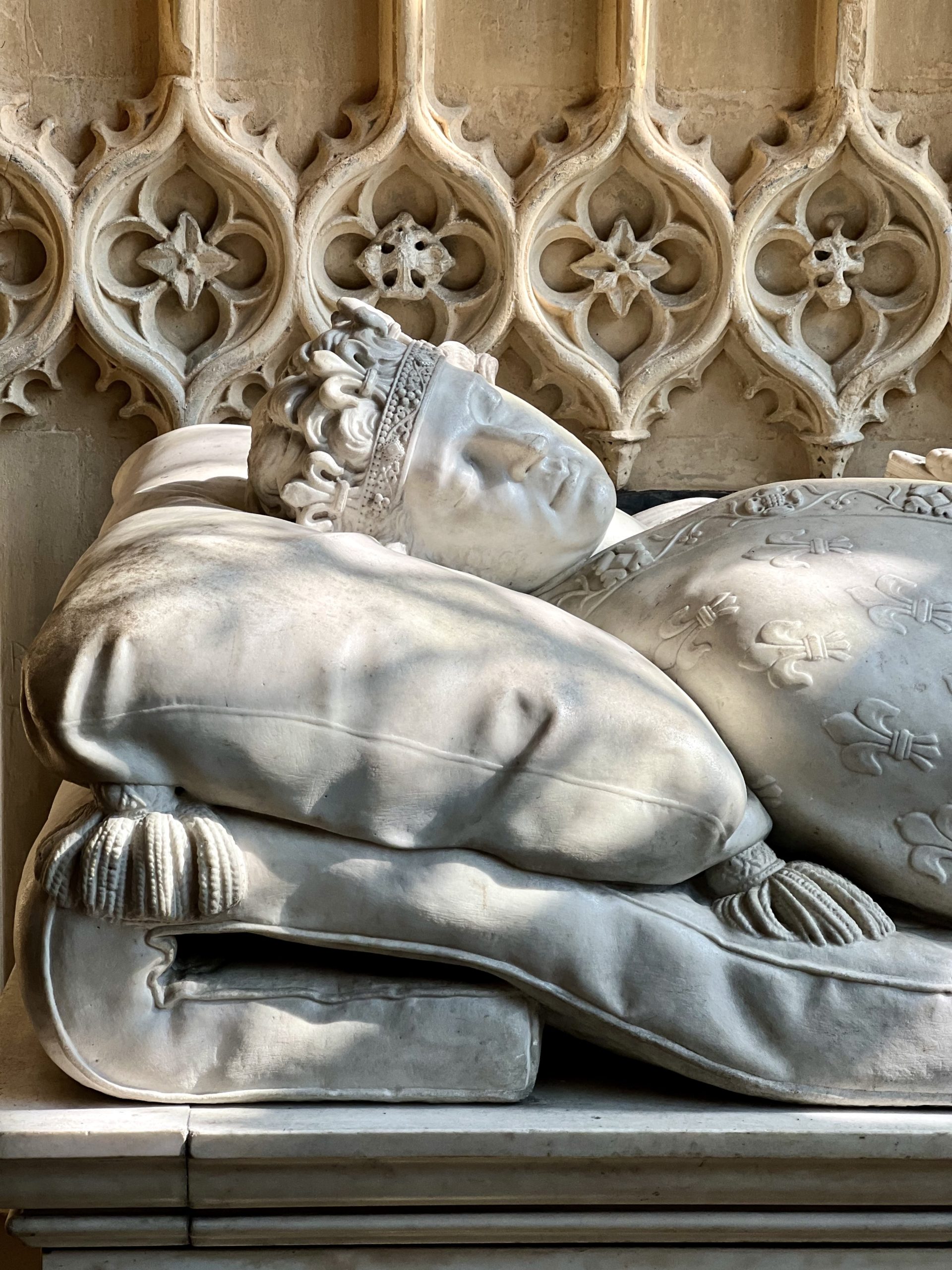
Mary Queen of Scots, who Elizabeth I executed for treason, is also buried there. Her tomb is grander than Elizabeth’s.
Having neglected his mother in life, Mary’s son James I commissioned a costly and majestic white marble monument in memory of his mother.
The Stuart monarchs and Hanoverian monarch are also buried there.
Another famous funerary item in the chapel is a white marble urn, which reputedly contains the remains of the “Princes in the Tower,” Edward V and his younger brother Richard, Duke of York. The casket was designed by the architect Christopher Wren.
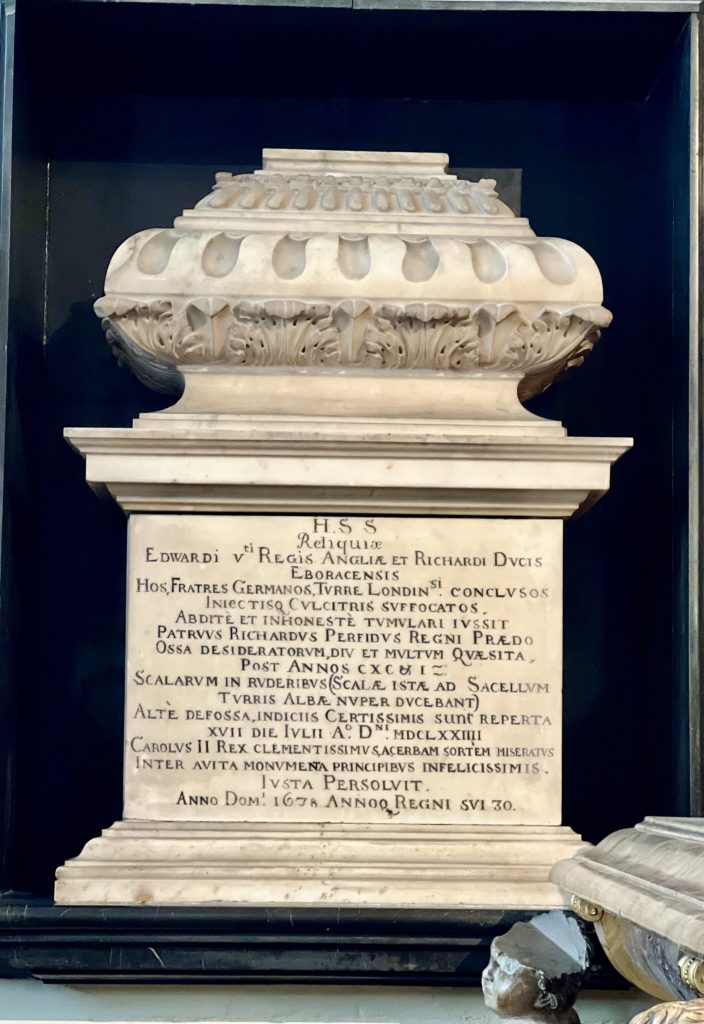
The princes were the sons of Edward IV, the brother of Richard III. While living in the Tower of London, the two princes disappeared in 1483.
Their uncle Richard III was subsequently crowned king. The princes’ fate is the greatest true crime cold case in English history, which I’ve written about at length.
Thanks mostly to posthumous Tudor propaganda, Richard III was accused of murder. In 1674, nearly two centuries later, workmen discovered the bones of two unidentified children in the tower.
It was immediately assumed the bones were those of the two princes. They were placed in the urn in the abbey on the order of Charles II. However, there’s no archeological, historical, or scientific evidence for that assumption.
You can also find the remains of the boy king Edward VI. He was Henry VIII’s only surviving son with his third wife Jane Seymour.
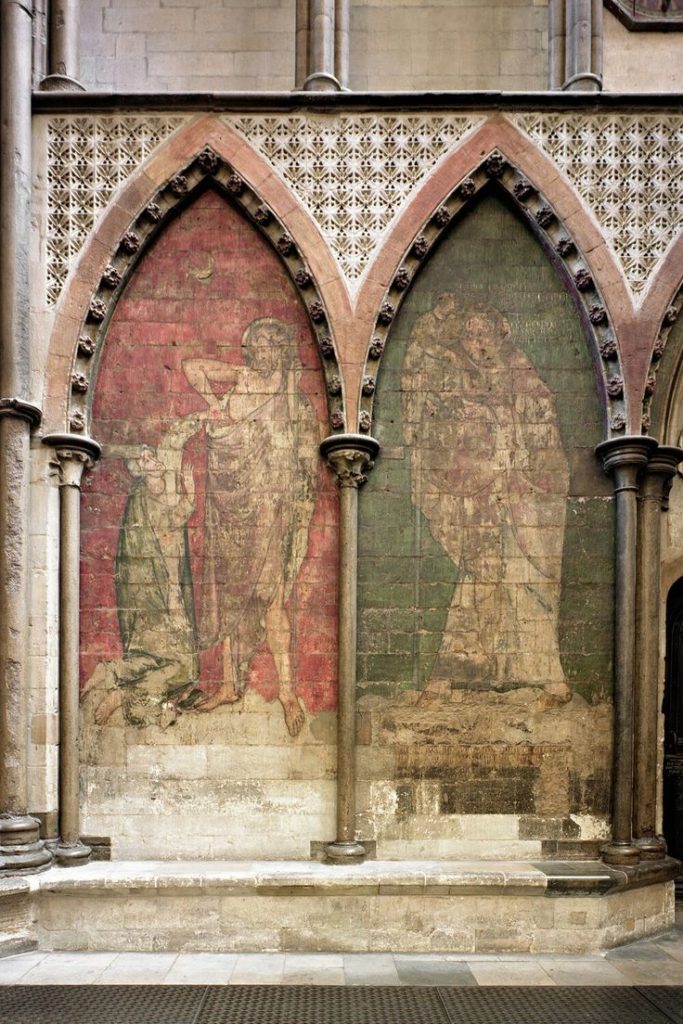
8. Medieval Paintings
In the south transept, you’ll find some important medieval paintings. The paintings depict the incredulity of St. Thomas and St. Christopher carrying the baby Jesus.
In 1936, they were discovered behind two monuments during cleaning in the south transept.
The paintings are thought to date from around 1270. They’ve been attributed to Master Walter of Durham, the King’s Painter under Henry III.
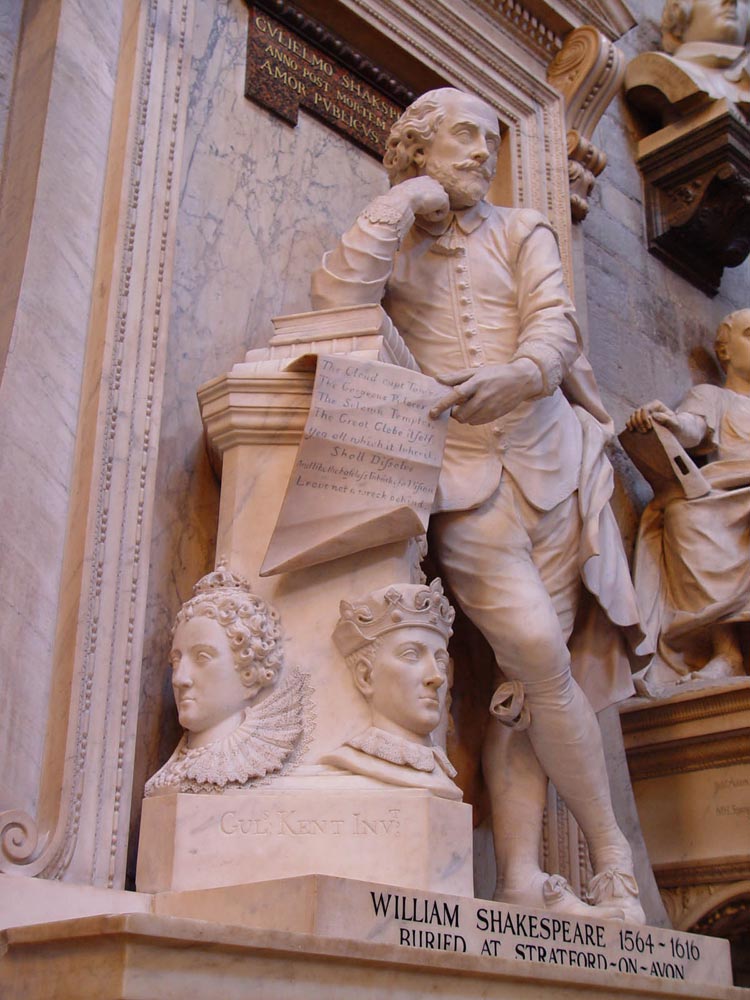
8. Poet’s Corner
The Poet’s Corner is also in the south transept. For lovers of English literature, strolling through Poets’ Corner can be a pilgrimage in itself.
This is where men and women of letters have been buried or commemorated for centuries. The tradition began almost by accident.
Geoffrey Chaucer was the first person buried in this part of the Abbey. Not because he was a poet, but because he worked at Westminster Palace next door.
The poet Edmond Spenser wanted to be buried near Chaucer. The precedent was set. The Poets’ Corner was born.
Other famous writers commemorated in Poets’ Corner are William Shakespeare, Robert Browning, Lord Bryon, Alfred Lord Tennyson, Lewis Carroll, CS Lewis, Charles Dickens, Rudyard Kipling, Thomas Hardy, Henry James, and Jane Austen.
There are even actors like Lawrence Olivier.
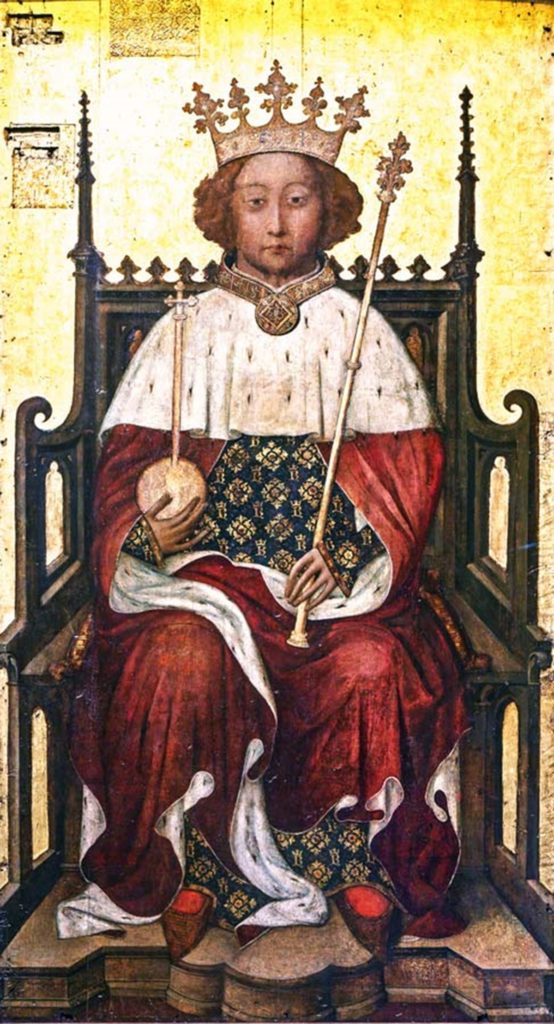
As space became more limited in the Poet’s Corner, names of newly honored writers are sometimes placed in stained glass or marble plaques. This is the case for Lord Byron, Oscar Wilde, and Christopher Marlow.
9. Painting of Richard II
A 14th century painting of Richard II hangs in the west end of the Abbey. You might miss if you don’t seek it out.
It’s an incredibly important work of art. It was the first portrait of an English sovereign to be painted in his lifetime. It’s one of the best medieval paintings in existence in any country.
The panting is 7 x 3.5 feet, but seems larger.
You can compare the painting to the king’s tomb effigy. His tomb is a double tomb with his Queen Anne of Bohemia. It’s near the shrine of Edward the Confessor.
For a period in the 18th century, a hole appeared on one side of the tomb. Visitors put in their hand, stealing his bones.
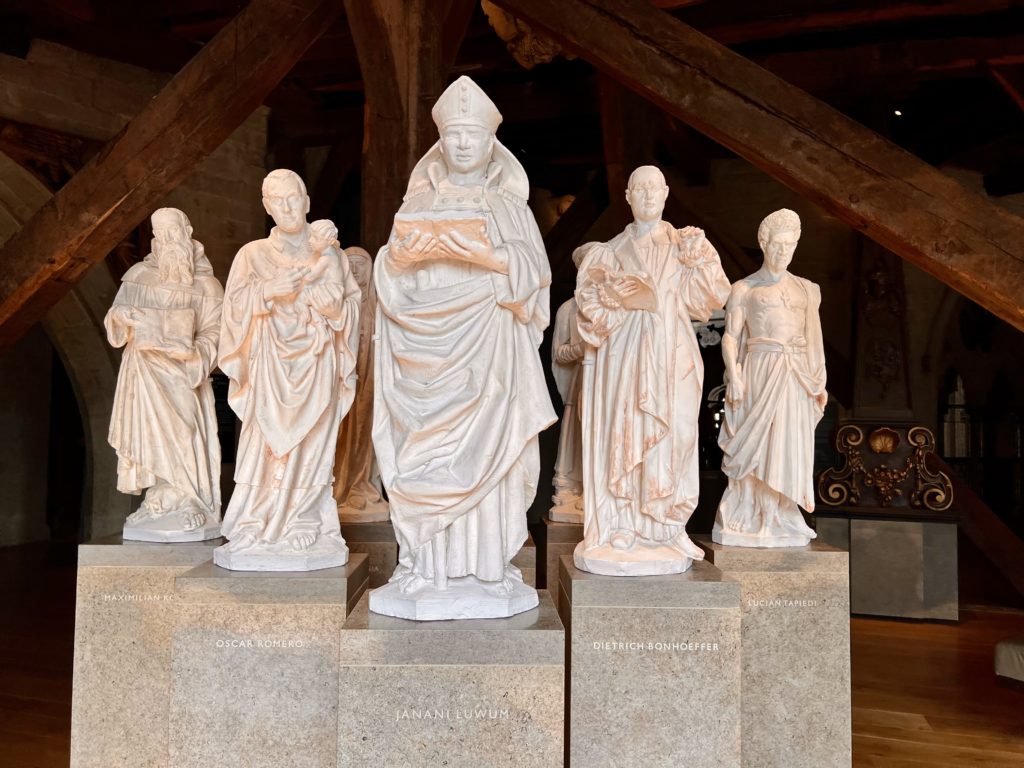
11. Queen’s Diamond Jubilee Galleries
You’ll want to pay the extra 5 pounds to climb up to the Queen’s Diamond Jubilee Galleries in the abbey’s Triforium. A triforium is a gallery above the arches of the nave and within the thickness of an inner wall.
The galleries opened to the public in 2018, after being hidden away for 800 years. They’re accessible from the new Weston Tower, the first addition to the abbey since 1745.
The galleries are in the eastern Triforium, which dates from 1250. The space were initially intended to be used for chapels. But high chapels fell out of fashion. The space was left empty.
The galleries have their own entrance to the right as you enter the abbey near Poet’s Corner. You can buy a ticket when you arrive at the abbey.
The galleries are 52 feet above the ground floor. It’s 100+ steps to the top.
You’ll have beautiful views of the abbey nave from atop. There’s also a lift, if you don’t want to hike up.
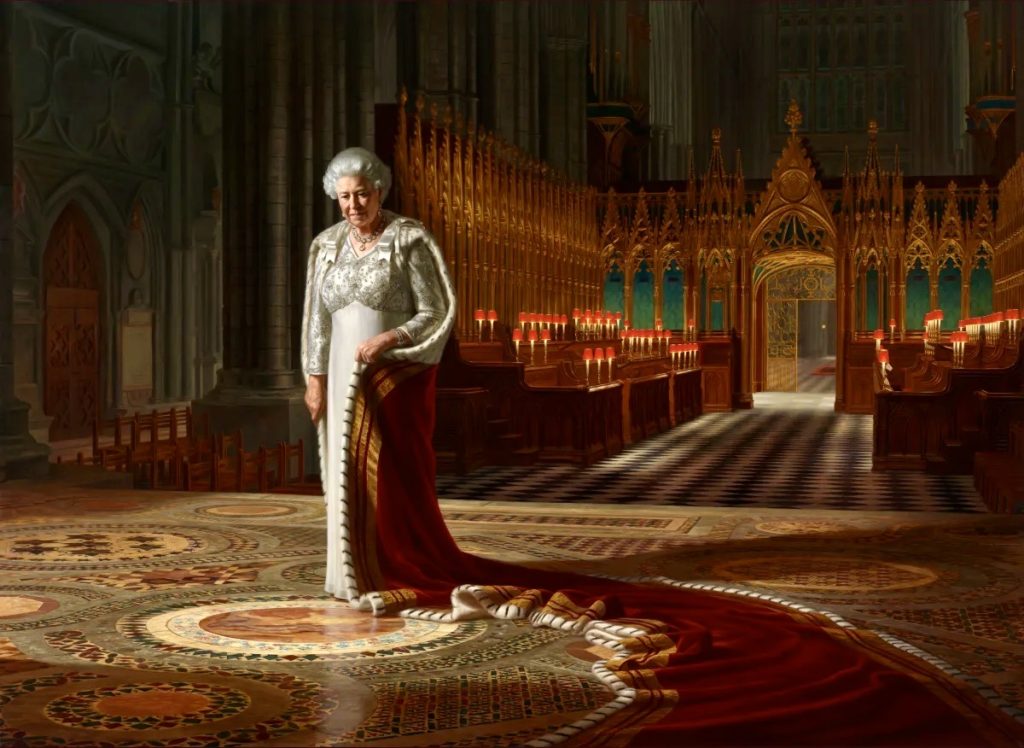
Over 300 special exhibits tell the story of the abbey’s 1,000 year history. You’ll see funeral effigies of the monarchs, rare books, tapestries, crowns, sculptures, swords, and coronation capes. You can even see the marriage license of William and Kate.
One of the most famous objects on display is the Westminster Retable. It was originally designed for Henry III’s high altar in 1269. It’s made of painted and gilded wood and has undergone extensive conservation.
There’s also a remarkable funeral effigy of Henry VII. It was likely modeled on his death mask, yielding an accurate physical representation. It may have been created by Italian artist Pietro Torrigiano.
There’s a massive 9 x 11 feet portrait of Elizabeth II by Ralph Heiman. It shows her on the Cosamati pavement in front of the high altar, on the exact spot where she was crowned in 1953.
Unfortunately, you can’t take pictures in this part of the abbey. The guards are especially vigilant in the area where you look down into the nave.
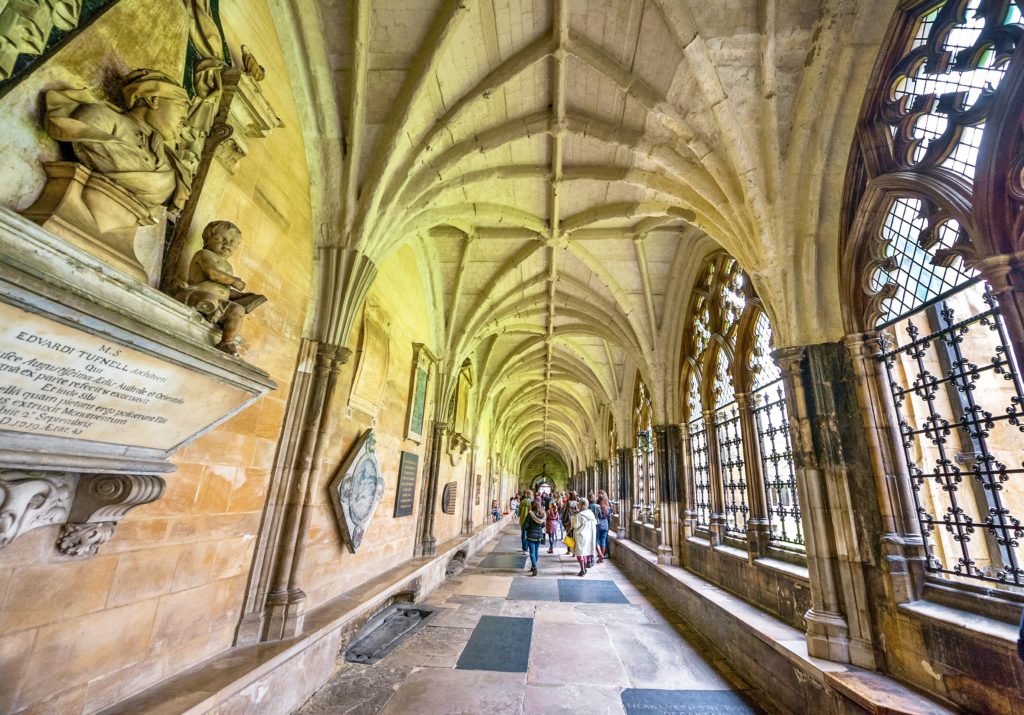
12. Cloisters
On the southeast side of the abbey as you’re heading out, you’ll find the place where the monks formerly lived, the medieval cloisters. They date from the 13th and 14th century.
The cloisters also housed the monks’ library and were used for recreation.
13. Chapter House
Off the east cloister is a vestibule leading to the Chapter House. This room is one of the largest chapter houses in Britain.
This is where the monks would meet each morning to listen to prayers and get their assigned duties.
The Chapter House was most likely built between 1246-55 on the orders of Henry III. Henry wanted his Chapter House to be “as the rose is the flower of flowers.”
The floor has medieval tiles. The beautiful tiles are some of the finest medieval tiles pavements in England. They were laid as a series of “carpets” running west to east from the entrance.
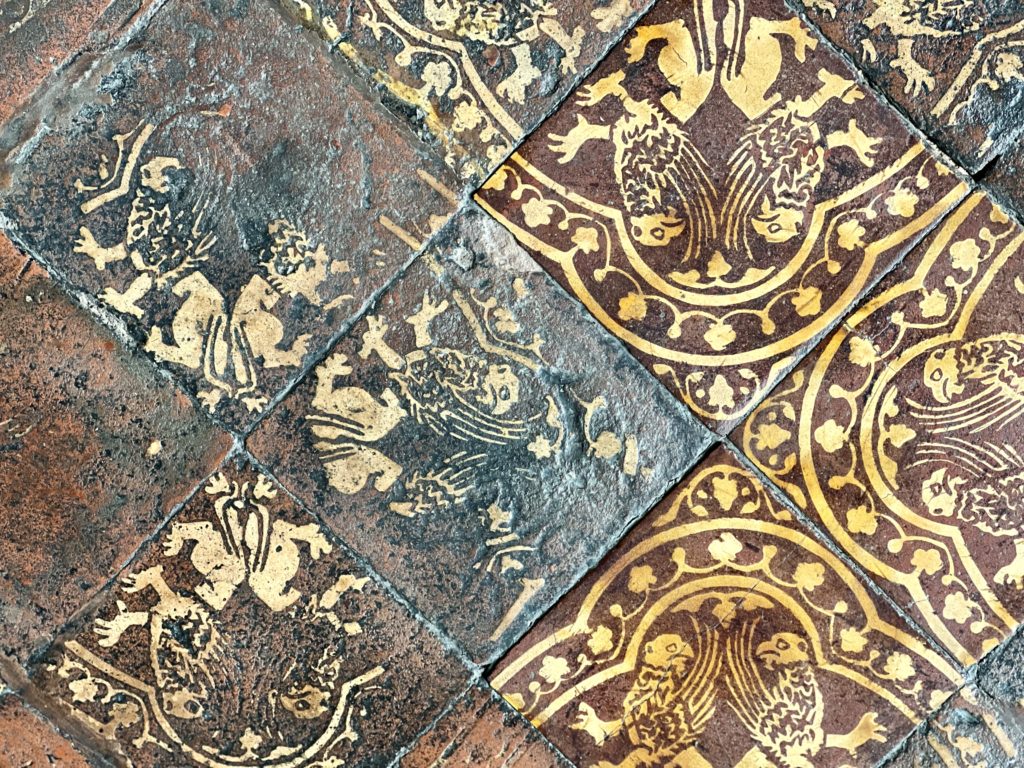
The designs were stamped via a pattern into clay and then filled with impressions with a lighter colored clay. You can see the coats of arms of Henry III with the three lions of England.
Some rare medieval paintings also survive on the Chapter House walls. They were painted around 1400 in the International Gothic style of art.
These paintings are the best preserved paintings from this era in all of England. They depict scenes from the apocalypse in a series of visions describe by St. John.
In the early 14th century, the crypt below the chapter house was used to store the regalia and royal money chests.
But it was broken into during the reign on Edward I when he was away on campaign. Though to be an inside job, nearly 50 monks were sent off to the Tower of London. They were only exonerated after a long trial.
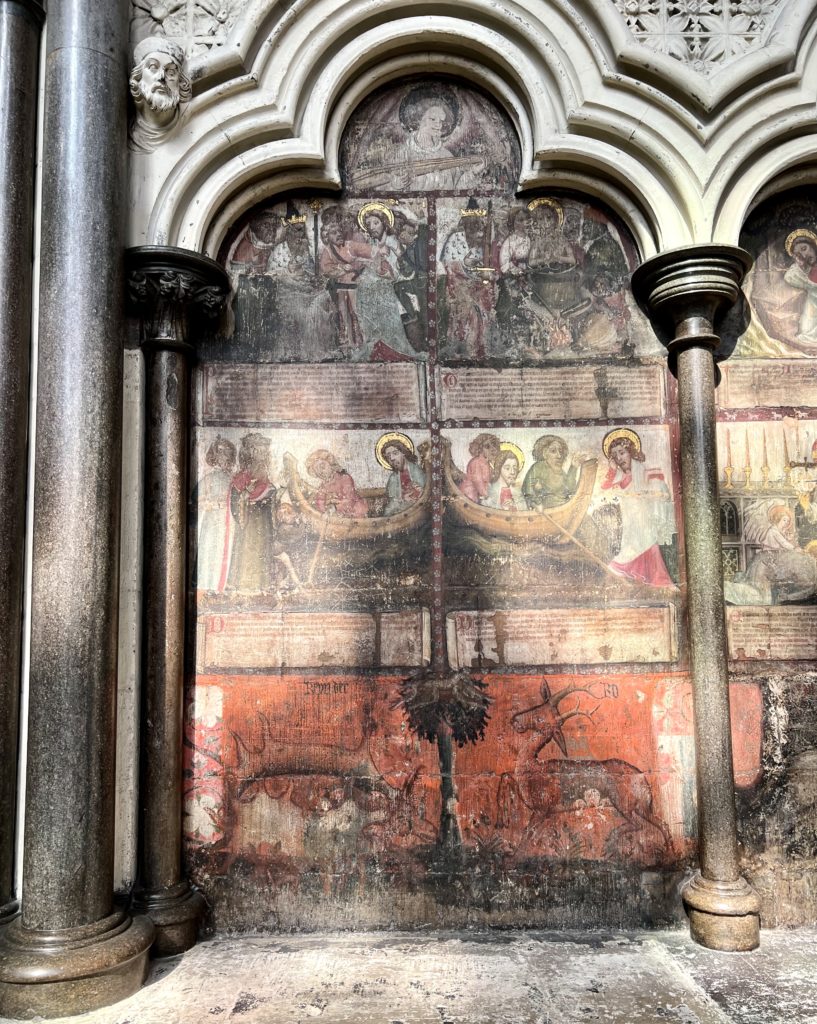
14. Pyx Chamber
The ancient Pyx Chamber is a room off the southwest corner of the cloisters. It dates from somewhere between 1065-90. It was originally the sacristy for Edward the Confessor’s old church, and is one of the few surviving remnants.
The Pyx Chamber has round arches and massive supporting columns. The chamber has a 13th century tiled floor.
If you walk through the dark rooms, you’ll come to the Little Cloister. This was the monks’ infirmary.
Beyond the Little Cloister is the abbey garden. At 900 years, it’s the oldest garden in England. This was where the monks grew herbs to make medicine. The garden is open to the public on certain days on the week.
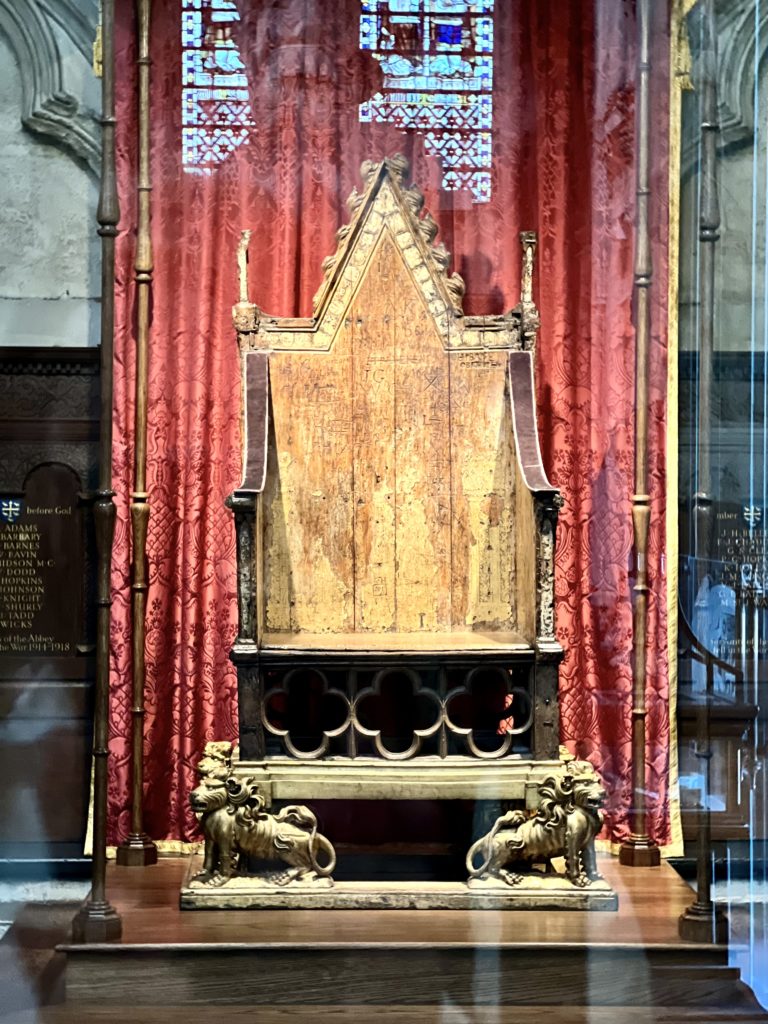
10. Coronation Chair
The Coronation Chair is on display just before you leave Westminster Abbey. It’s the oldest piece of furniture in Britain still used for its original purpose.
While coronations have taken place at the Abbey since 1066, the chair has only been used for the last 700 years. The lions around the base were added in 1727.
Originally, it was sumptuously decorated and gilded. But it’s been rather abused over the years, with graffiti carvings and the like.
The chair once held the famous Stone of Scone, also known as the Stone of Destiny. In 1296, the stone was captured by Edward I as spoils of war, taken to the abbey, and fitted into the wooden chair.
In 1996, the stone was restored to the people of Scotland and moved to Edinburgh Castle. But it will return for the next coronation upon the death of Elizabeth II.
Unfortunately, you can’t get too close to the Coronation Camber, which is behind glass. But that’s understandable given its age and significance.
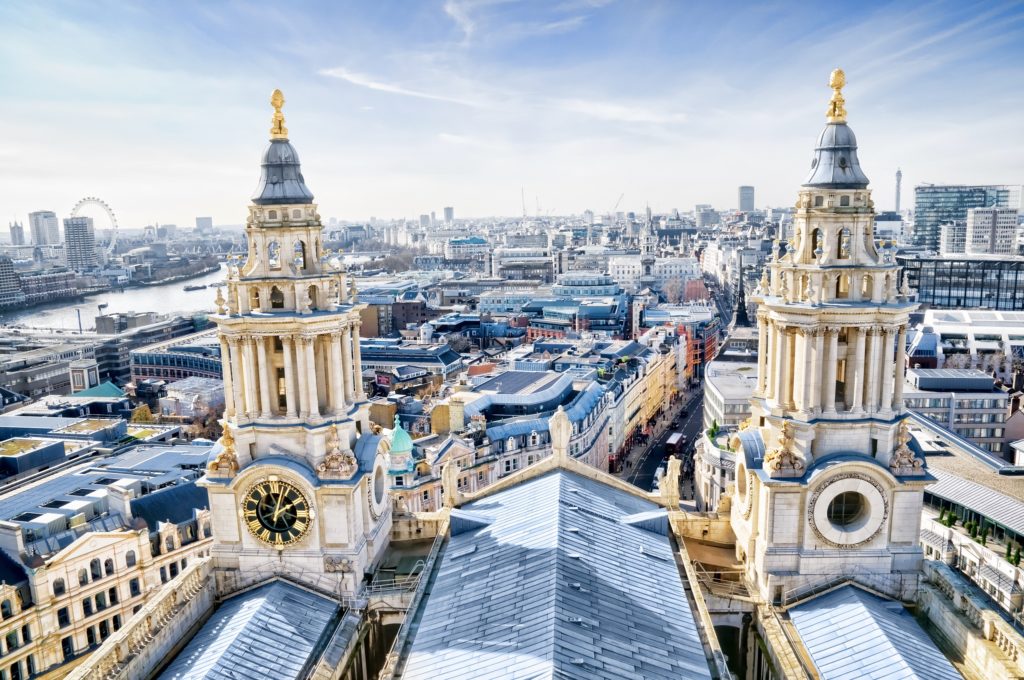
Practical Guide & Tips For Westminster Abbey
Here are some must know tips for visiting the Westminster Abbey.
1. Should You Visit Westminster Abbey Or St. Paul’s Cathedral?
Ideally, you should visit both of these iconic landmarks on a visit to London. But you may not have time. And they could not be more different. If pressed, I would pick the abbey.
Westminster Abbey is more centrally located in the heart of the city. It’s steeped in history and will appeal to lovers all of things ancient and Gothic.
In addition, if you are interested in royal history, the abbey is where you can pay homage to your favorite king or queen.
St. Paul’s is also a worthy bucket list attraction and Christopher Wren’s defining architectural masterpiece. The Baroque architecture, mosaics, monuments, and the dome itself are all stunning.
One key advantage St. Paul’s has over Westminster Abbey are the viewing galleries in the dome. You have fantastic views of all of London. You can read my complete guide to St. Paul’s Cathedral.
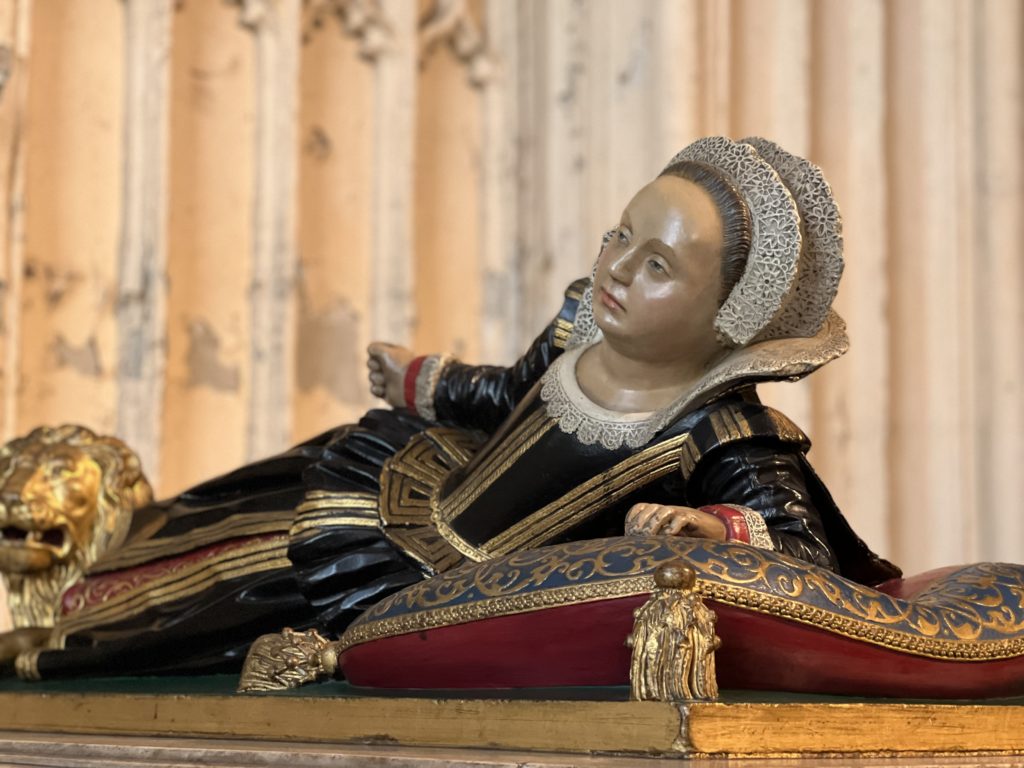
2. Where To Stay Near Westminster Abbey
Want to stay near Westminster Abbey? It’s a good area for sightseeing with many attractions nearby.
The best place to stay is the St. Ermin’s Hotel, a place of sophistication and elegance. You enter through a tree-lined courtyard.
The Guardsman is also a fine choice. It’s a beautiful boutique hotel in heart of London with the feel of a members club. It has a location fit for kings and queens near Buckingham Palace.
Taj 51 Buckingham Gate has five star luxury suites, with restaurants and an in house spa.
3. When To Visit Westminster Abbey
Try to arrive about 20 minutes before opening time at 9:30 am. There may already be a line. But tourist groups will start coming later and the abbey will be even more crowded.
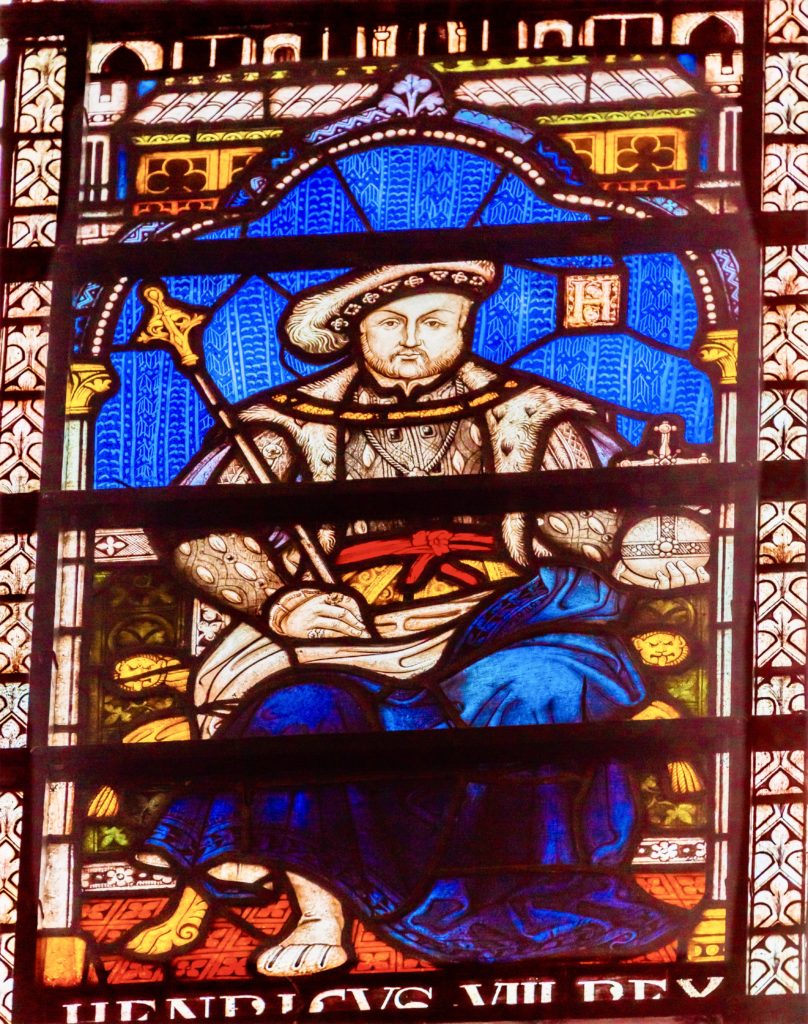
4. How Long To Visit Westminster Abbey
This totally depends on your interest in the individual monuments and effigies. I estimate 90 minutes to 2 hours for most people.
But you could easily spend 3 hours there, if you have a more leisurely schedule and want to read everything.
5. Verger Tours Of Westminster Abbey
Vergers are abbey staff who attend to the cathedral’s important visitors and help the clergy. Verger tours last approximately 90 minutes.
You can only book one at the information desk after your arrival at the abbey. You can’t book them online. They cost an additional £10.
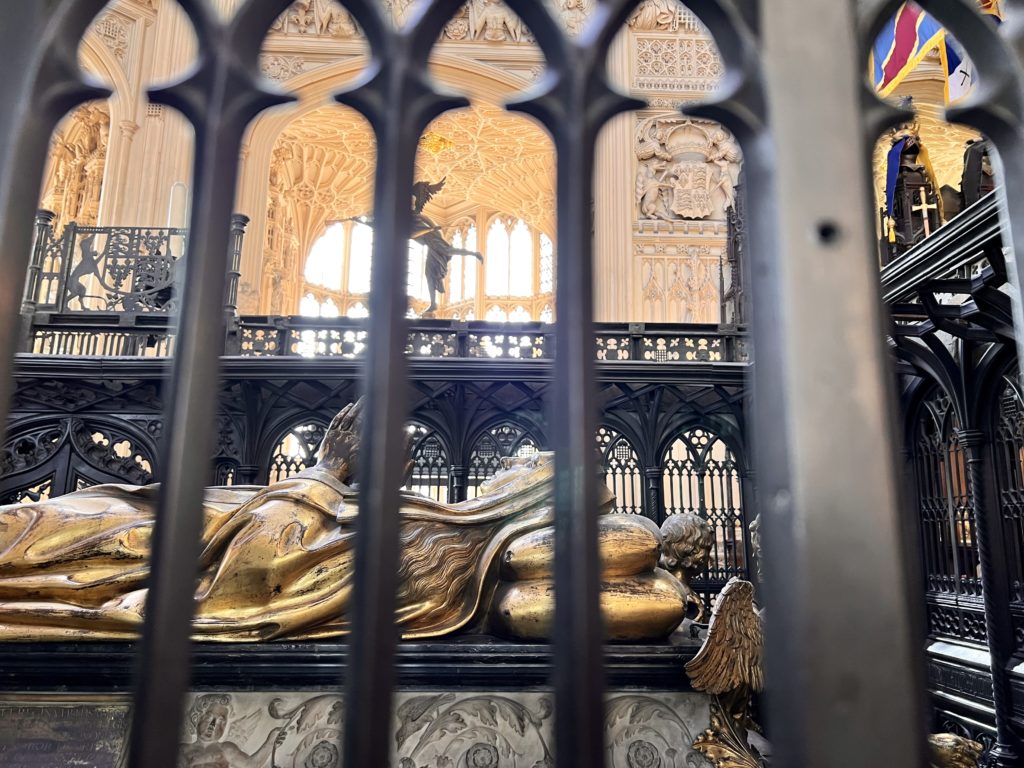
I highly recommend taking one if you can! The vergers are incredibly knowledgable abbey experts. They can take you to places not accessible on a general visit, such as the tomb of Edward the Confessor.
But you need to plan your visit in advance to coincide with the tours. They leave at 11:00 am, 11:30 am, and 2:00 pm.
6. Other Practical Information
Address: 20 Deans Yard London
Hours: Click here for hours. The abbey isn’t open on Sunday.
Ticket Prices:
The standard ticket price for the abbey is £ 25. You have free entry with the London Pass, but cannot enter via the fast trick line. It’s free to visit the abbey during a service, but you cannot sightsee. An audioguide is free with admission.
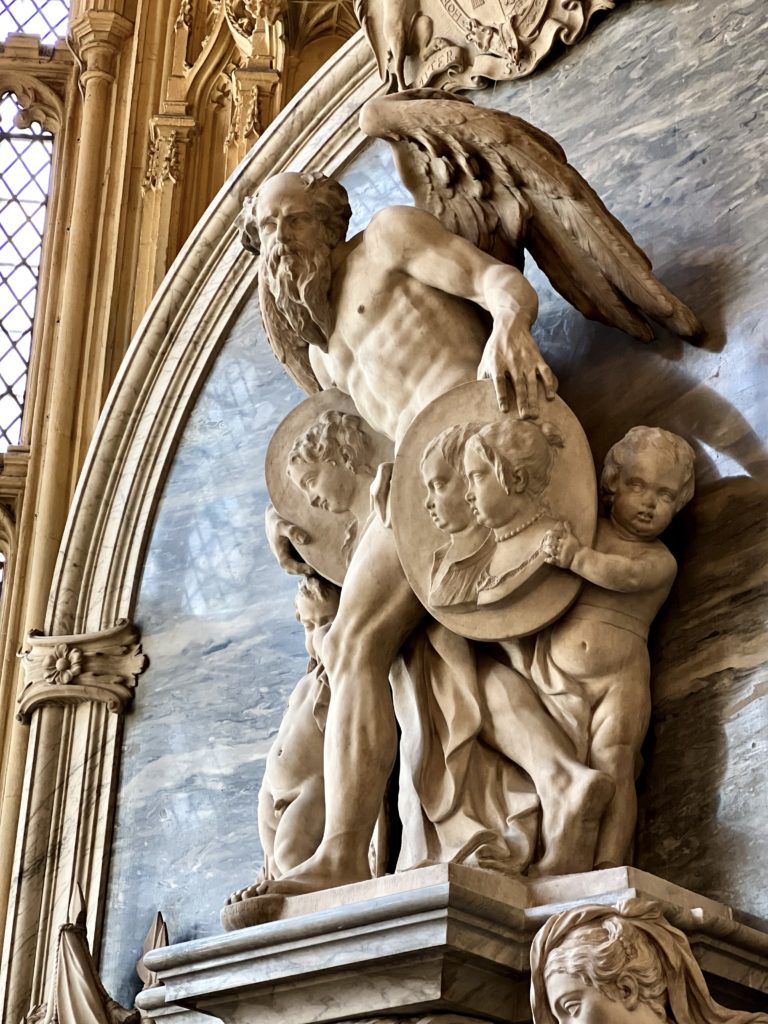
Tube Station: Westminster is the closest. Victoria and St. James are the next nearest.
Westminster Abbey App:
The abbey has a multimedia guide that you can download in advance on your phone.
Photography: You can take photos for non-commercial use in the abbey, but not in the Queen Galleries.
I hope you’ve enjoyed my guide to Westminster Abbey. You may enjoy these other London travel guides:
- 3 Days in London Itinerary
- 5 Days in London Itinerary
- One Day In Bath Itinerary
- Guide To Free Museums in London
- Guide To the National Gallery of Art
- Harry Potter Places in London
- Guide To the Churchill War Rooms
- Guide To St. Paul’s Cathedral
- Guide To The Wallace Collection
- Tourist Traps To Avoid in London
- Guide To the Tower of London
If you need a guide to Westminster Abbey, pin it for later.

